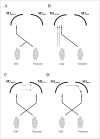Mirror movements in movement disorders: a review
- PMID: 23440079
- PMCID: PMC3569961
- DOI: 10.7916/D8VQ31DZ
Mirror movements in movement disorders: a review
Abstract
Background: Mirror movements (MM) are involuntary movements of homologous muscles during voluntary movements of contralateral body regions. While subtle mirroring can be present in otherwise healthy adults, overt MM may be common in many movement disorders. Examining these collective findings may further our understanding of MM and help define their usefulness as a clinical sign.
Methods: We sought to review English language research articles examining the presence, clinical significance, and/or pathophysiology of MM in Parkinson's disease (PD), corticobasal syndrome (CBS), essential tremor (ET), focal hand dystonia, Creutzfeldt-Jakob's disease (CJD), and Huntington's disease. When available, MM in these disorders were compared with those of healthy age-matched controls and congenital disorders such as Klippel-Feil syndrome and X-linked Kallman's syndrome.
Results: Clinical presentation of MM is common in asymmetric parkinsonian disorders (early PD, CBS) and manifests differently depending on the side affected (less affected hand in PD, more affected hand in CBS, either hand in ET, and both hands in healthy adults and congenital disorders), stage of disease (early, asymmetric PD and CJD), and presence of concomitant mirror-like overflow phenomena (focal dystonia and CBS-associated alien hand). In general, uncrossed descending corticospinal projections (congenital MM) and/or abnormal activation of the motor cortex ipsilateral to the voluntary task (most acquired MM), i.e., activation of the normal crossed corticospinal pathway, are required for the generation of MM.
Discussion: MM are common motor phenomena and present differently in several acquired (mostly neurodegenerative) and congenital movement disorders. Future studies on MM will enhance the clinical diagnosis of selected movement disorders and contribute to our understanding of the normal physiology of bimanual coordination.
Keywords: Mirror movements; Parkinson's disease; corticobasal degeneration; essential tremor; focal hand dystonia.
Conflict of interest statement
Figures

References
-
- Regli F, Filippa G, Wiesendanger M. Hereditary mirror movements. Arch Neurol. 1967 - PubMed
LinkOut - more resources
Full Text Sources

